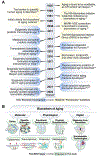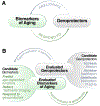Biomarkers of aging for the identification and evaluation of longevity interventions
- PMID: 37657418
- PMCID: PMC11088934
- DOI: 10.1016/j.cell.2023.08.003
Biomarkers of aging for the identification and evaluation of longevity interventions
Abstract
With the rapid expansion of aging biology research, the identification and evaluation of longevity interventions in humans have become key goals of this field. Biomarkers of aging are critically important tools in achieving these objectives over realistic time frames. However, the current lack of standards and consensus on the properties of a reliable aging biomarker hinders their further development and validation for clinical applications. Here, we advance a framework for the terminology and characterization of biomarkers of aging, including classification and potential clinical use cases. We discuss validation steps and highlight ongoing challenges as potential areas in need of future research. This framework sets the stage for the development of valid biomarkers of aging and their ultimate utilization in clinical trials and practice.
Copyright © 2023 Elsevier Inc. All rights reserved.
Conflict of interest statement
Declaration of interests M.M., V.S., M.P.S., and V.N.G. have filed patents on measuring aging. C.H. is affiliated with the Institute for Biomedical Aging Research, Universität Innsbruck, Austria and an honorary research fellow at the Department of Women’s Cancer, EGA Institute for Women’s Health, University College London, United Kingdom. C.H. and M.W. are shareholders of Sola Diagnostics GmbH and named as inventors on a patent on an epigenetic clock indicative of breast cancer risk. J.N.J. is affiliated with the Sticht Center for Healthy Aging and Alzheimer’s Prevention, Wake Forest University School of Medicine, Winston-Salem, NC, USA and the XPRIZE Foundation, Culver City, CA, USA. J.N.J. also serves on the advisory board for the American Federation for Aging Research (AFAR)’s Finding Aging biomarkers by Searching existing Trials (FAST) Initiative and the editorial board of Journals of Gerontology Series A Biological Sciences, eLife, and Experimental Gerontology. D.W.B. is affiliated with the Child Brain Development Network, Canadian Institute for Advanced Research and SocioMed Research Nucleus, Universidad Mayor, Santiago, Chile. D.W.B. also serves on the advisory board for the American Federation for Aging Research (AFAR)’s Finding Aging biomarkers by Searching existing Trials (FAST) Initiative and the editorial board of Journals of Gerontology Series A Biological Sciences and is an inventor of DunedinPACE, a Duke University and University of Otago invention licensed to TruDiagnostic. A.A.C. is a founder, president, and majority shareholder at Oken Health. I.B. is affiliated with the SOMT University of Physiotherapy, Amersfoort, The Netherlands and is a member of the clinical advisory board of Rejuvenate Biomed. M.W. is affiliated with the Institute for Biomedical Aging Research, Universität Innsbruck, Austria. N.B. is the Scientific Director of the American Federation for Aging Research (AFAR), on the board of the executive committee of the Longevity Biotech Association, and advisor on the Board of the Academy for Health and Lifespan Research. M.K. is an employee and shareholder of Optispan Inc., a company developing tools to enable science-based personalized and preventative geromedicine. The Regents of the University of California is the sole owner of a patent application directed at GrimAge and other epigenetic clocks for which S.H. is a named inventor. S.H. is also a founder and paid consultant of the nonprofit Epigenetic Clock Development Foundation that licenses patents surrounding epigenetic clocks. A.B.M. is the Chief Medical Officer of NU. V.N.G. is a scientific advisor to Retro and Dior. M.P.S. is a cofounder and scientific advisor of Personalis, SensOmics, Qbio, January AI, Fodsel, Filtricine, Protos, RTHM, Iollo, Marble Therapeutics, Crosshair Therapeutics, and Mirvie. M.P.S. is also a scientific advisor of Jupiter, Neuvivo, Swaza, and Mitrix. V.S. is co-founder, SAB chair, and head of research of Turn Biotechnologies.
Figures




References
-
- Cohen AA, Kennedy BK, Anglas U, Bronikowski AM, Deelen J, Dufour F, Ferbeyre G, Ferrucci L, Franceschi C, Frasca D, et al. (2020). Lack of consensus on an aging biology paradigm? A global survey reveals an agreement to disagree, and the need for an interdisciplinary framework. Mech. Ageing Dev 191, 111316. 10.1016/j.mad.2020.111316. - DOI - PMC - PubMed
Publication types
MeSH terms
Substances
Grants and funding
LinkOut - more resources
Full Text Sources
Other Literature Sources
Medical

